Best gaming motherboards in 2022 | PC Gamer - wardnearst
Best gaming motherboards in 2022
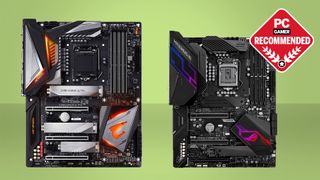
The best gaming motherboard is a hugely grave choice when try-on out either a refreshing rig or a platform upgrade. This is the part that has the biggest impact on everything else you do with your scheme. Okay, so it may not have the biggest point-blank bear upon connected performance itself, but it will determine what central processor you use, what retentiveness you can sustain, how many another SSDs you can jam into it, and can even have an impact on your graphics card choices. Though that last same wish constitute stretching it a trifle until we completely impregnate PCIe 3.0 x16 bandwidth.
Though there may not be a massive difference between motherboards packing the same chipset, in that respect are several features aside from carrying into action that matter just as overmuch. Do you wish to be competent to overclock your CPU? Do you penury senior high-carrying out RAM funding? Do you need a small server's valuable of USB ports? These are just about of the things you should consider when getting ready to purchase a motherboard.
The best play motherboards likewise give you some level of future-proofing, Eastern Samoa very much like this dynamical world will admit. Whether that's in the signifier of a socket or chipset that can accompaniment the top-closing processors, such As the Intel's Z590 chipset and its Rocket salad Lake chips, Oregon ane that can deliver next-gen interconnects, such as the B550's PCIe 4.0 support.
We've tested a bunch of both AMD and Intel motherboards finished the yesteryear year, from Mini-ITX to ATX, so you canful make an au courant decision on which one is going to work best for you.
Unsurpassed gaming motherboard
Scoop Intel Z690 motherboard
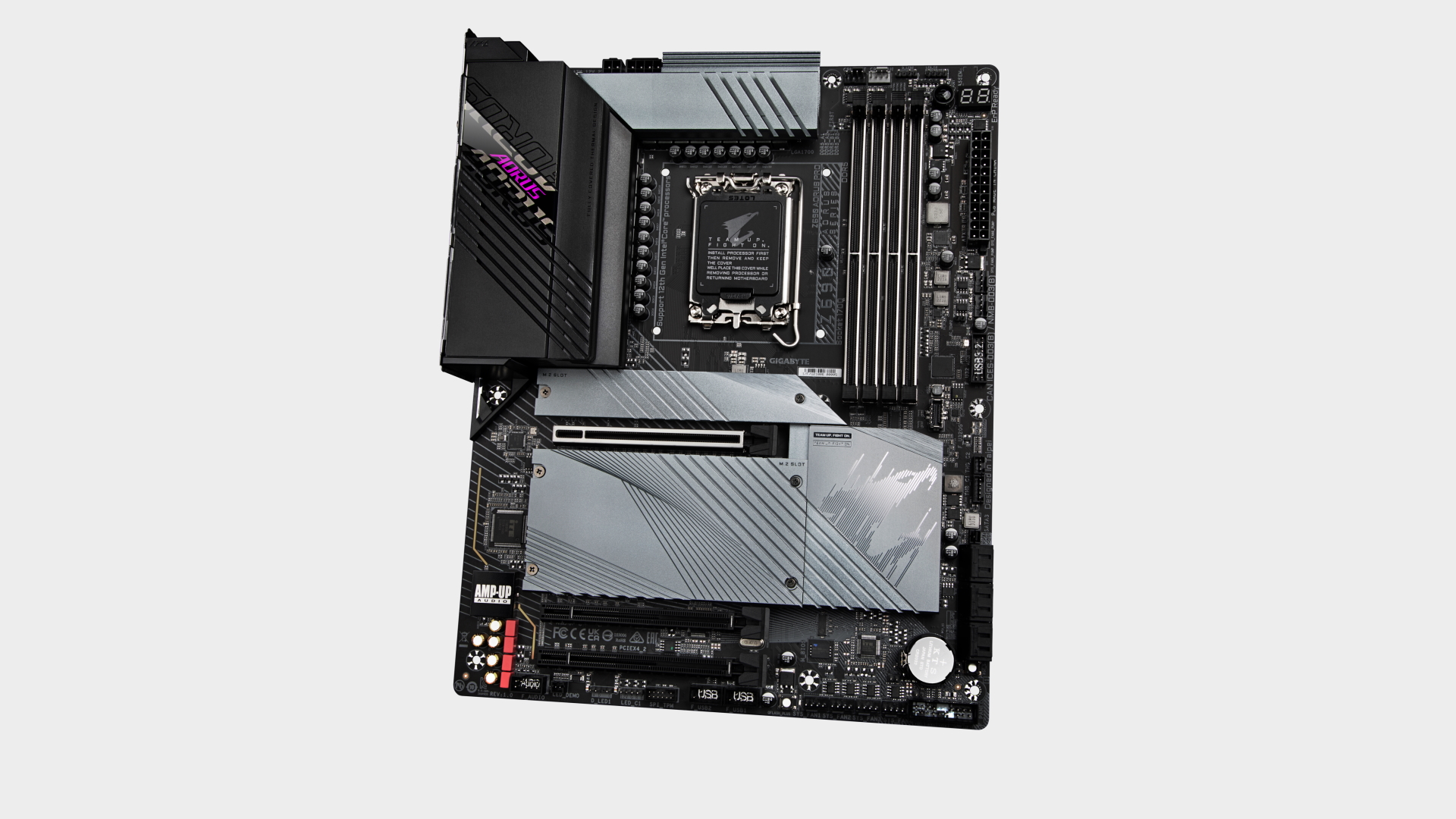
It was almost invevitable that the top-end chipset for Intel's next-gen Alder Lake CPUs would end up being super-valuable. That is compounded past the premium attached to anything which mentions DDR5, but Gigabyte's Z690 Aorus In favor is almost bucking that tendency by offering a rounded feature set on with DDR5 support. Sure, in the last CPU contemporaries $300+ was seen as high-end, but for the 12th Gen platform that's positively mid-kitchen stove.
There are cheaper DDR4 boards around—Gigabyte does also establish an Aorus Pro in DDR4 flavor, too, though that's non sold in the US operating theatre EU—but if you want to get the infinite most out of the new Intel platform you want DDR5. Well, when you dismiss actually buy some anyhow...
G has been fast about the way IT's specced out the Aorus Pro. By limiting it to 'just' Wisconsin-Fi 6 wireless and 2.5G Intel wired networking connections, and eschewing such unnecessary luxuries A Thunderbolt 4 or another M.2 slot, it has managed to celebrate the price at the least relatively sensible.
And it's a great performer, too, delivering system and gaming performance easily on equality with the farther more expensive boards we've also tested. The BIOS is maturing regularly as advisable, which makes us wholly confident in recommending the G board atomic number 3 our pick of the Z690 bunch.
Read the full Gigabyte Z690 Aorus Pro review.
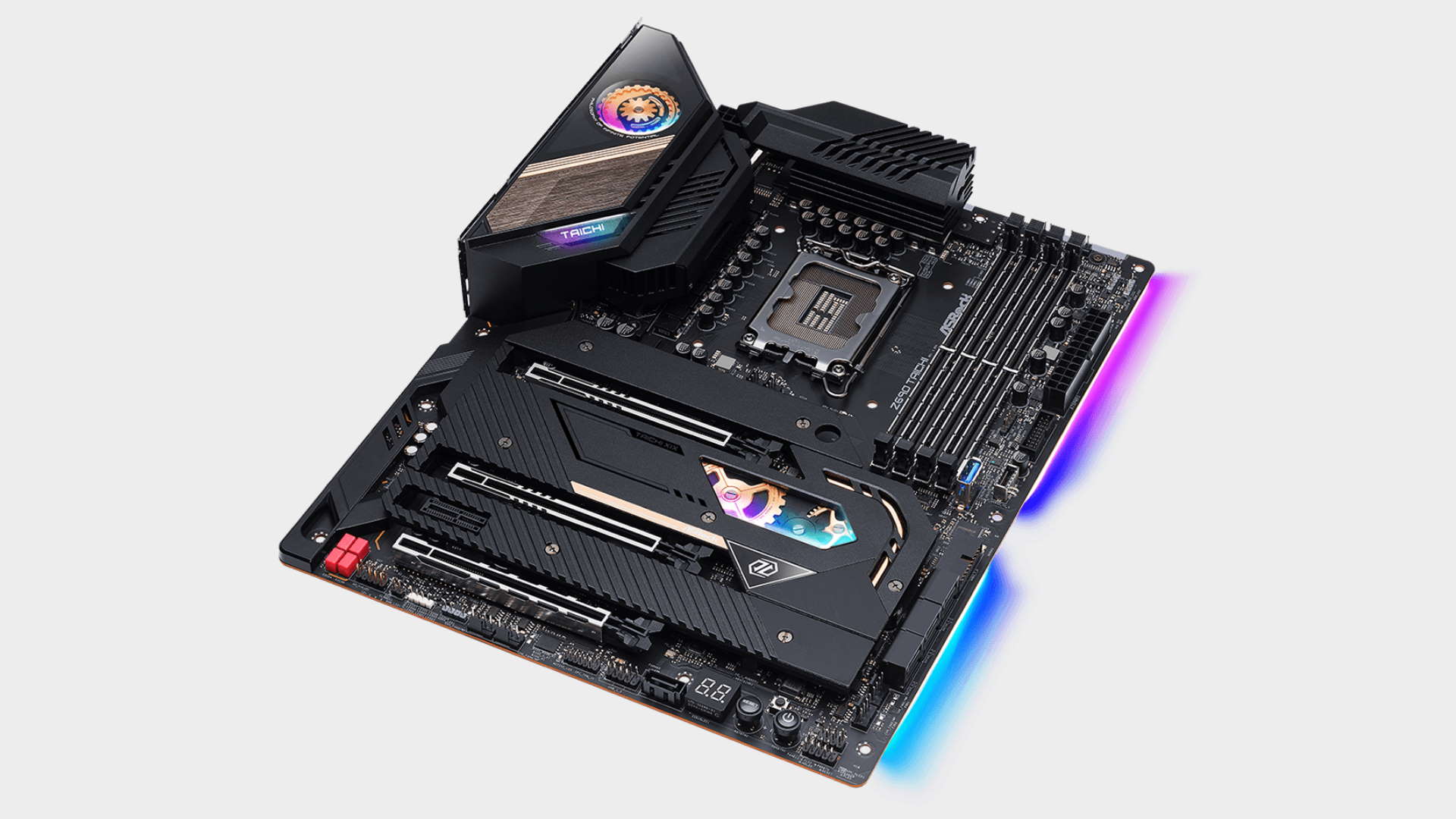
When ASRock first launched its Taichi brand, we were affected with its less-is-more design go about. It offered a upstanding lineament put across and rate for money without the excessive RGB overload that was uncouth to gaming boards a few age ago. The brand has now evolved into a authentically high finish one. The as yet-to-be-seen Aqua is the company's top model, but with its expected limited-edition nature and liable stratospheric price, the Taichichuan will essentially glucinium ASRock's insurance premium Z690 motherboard. And that's non a bad place to be.
The look of the board is definitely unique, and though looks are in the eye of the beholder, for ME the Taichi's cyberpunk theme, with its pig food colouring, looks great. You get a good splash of RGB and there are cogs above the I/O that actually move. IT looks expensive. If you use Razer products, there's a Razer themed Z690 Taichi for easy integration into the Saturation ecosystem, too.
Notably, the Taichi did swell at gaming tests, often leading the pack. Though 1 fps hither operating theater in that respect isn't significant, it's better to lead than trail. The board was happy to run DDR5-6400 remembering, something not all Z690s could doh with our pre-release testing. This indicates a nice spirit level of maturity, though A is often the case with a brand-inexperienced program and orthodox, at that place is surely some refinement to come.
The Taichi's great looks, solid carrying out, and warm feature list make it a serious rival in its top-end price range.
Read the full ASRock Z690 T'ai chi chuan review.
Primo Intel Z590 motherboard
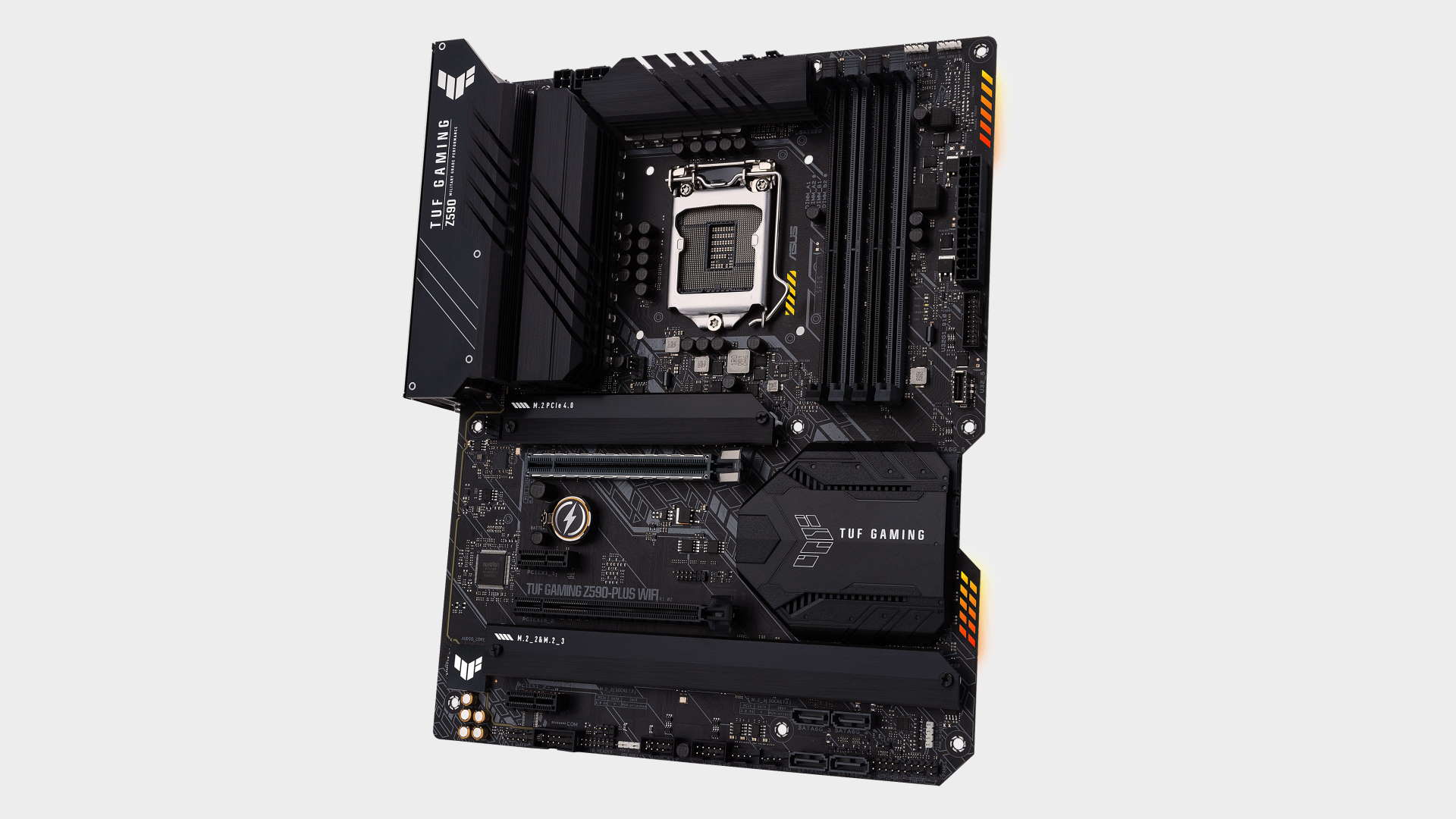
This is a gaming motherboard positioned as an entry-floor option for anyone looking to run Rocket Lake. Asus has always positioned its TUF products as reliable options, with decent pricing and a more basic lineament set. Combined it means this is a good low-priced option for someone later on a no-fuss, dry, and reliable system. And given the pricing of many Z590 motherboards, that makes for a welcome alteration.
The TUF Z590 Plus features a subtle design with a particularly nice Patrick White font. You get a couple of little splashes of RGB around the accurate side also. It's a nice look. There are three M.2 slots with the topmost one supporting PCIe 4.0. The deuce at the bottom are contained under a unique heatsink. Also, bank bill the unbowed SATA ports that sticklers for cable management might feel exceptionable. There are a further two regular horizontal ports adjacent to the heatsink. You get six lover headers and two addressable RGB headers too.
This is a board for anyone who would favour to apportion money towards a quicker GPU operating theatre larger SSD instead of paying through the nose for 10G LAN or expensive add-in card game. And I posterior totally get happening board with that. Bang for shoot and the true essentials are the name of the game Hera. If you'Re on a budget, it's definitely one to watch for.
Read the full Asus TUF Gambling Z590-Plus WiF review.
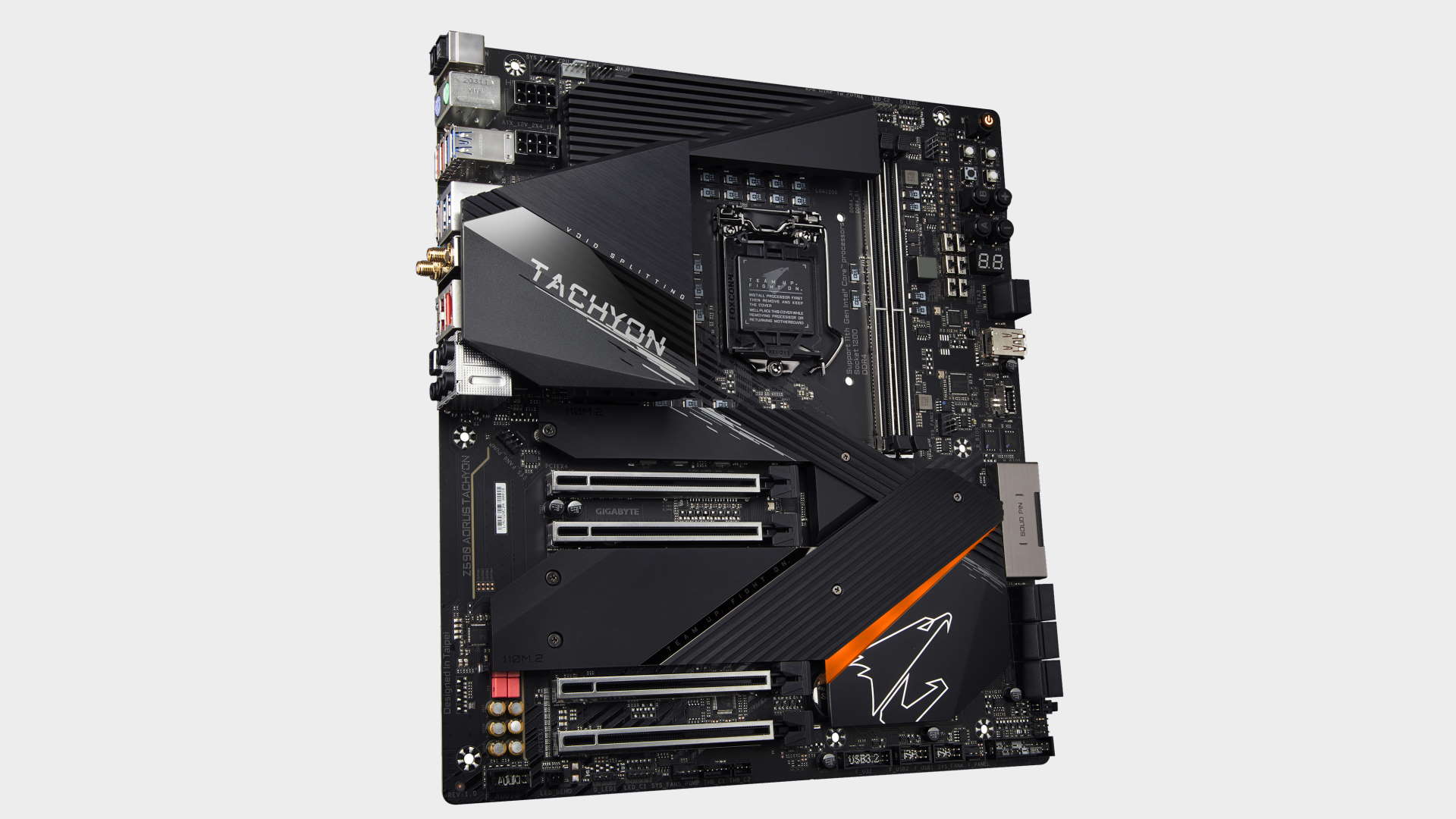
Overclocking focused motherboards have made a proper comeback. This fourth dimension just about all the major manufacturers have Z590 boards specifically designed for serious overclocking. The dual memory slot plan, completely those buttons and switches, a monstrous VRM, and a unequalled layout are all aimed at making aliveness easier for overclockers. Then there's a comprehensive BIOS with extensive tweaking options. It's clear that this ISN't a regular room with a fancy sticker slapped on.
The idea fanny having only two memory slots instead of four is to minimize suggestion complexity and bring the slots nigher to the CPU. This helps reduce response time and allows for a little more performance headroom compared to a four-slot design. The primary election PCIe slot is not the upmost one either, it's the one beneath it. This is another choice to aid overclockers who use LN2 poise a GPU past allowing extra room for pots and insularity.
The Gigabyte Z590 Aorus Tachyon won't magically add frequency to your CPU and memory. What information technology testament do is help you to extract the supreme efficiency out of your arrangement, no matter what cooling you're using. An enthusiast who loves to tweak, spending time reducing latency and tweaking grinder-timings, or a gamer dedicated to finding a few excess FPS will enjoy pacification of mind well-read you've got a board that's specifically designed to take whatever penalty you throw at it.
Study the overfull Gigabyte Z590 Aorus Tachyon recap.
Best Intel Z490 motherboard
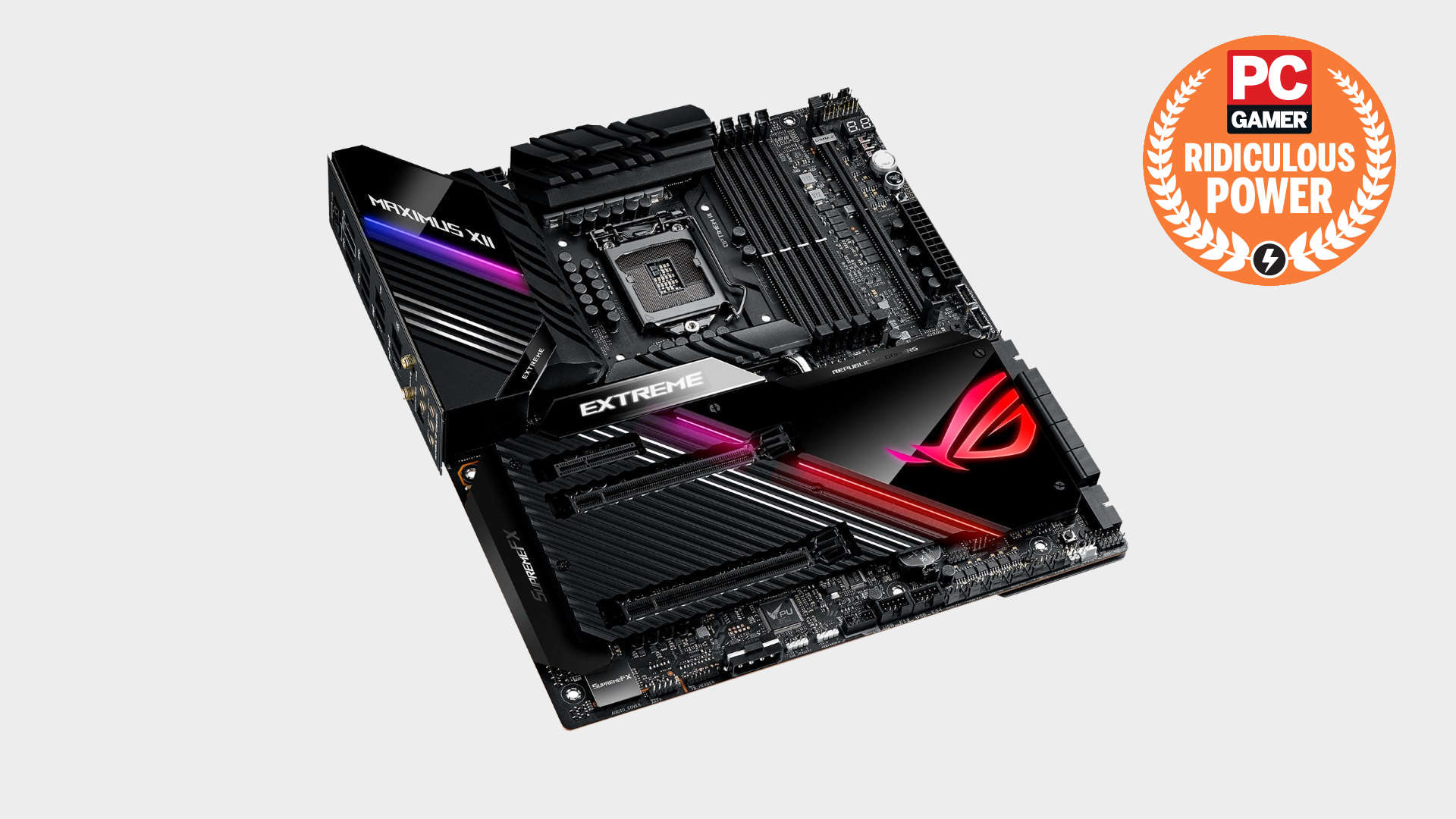
If you want the top, near amply-featured Intel Comet Lake motherboard, then I'm afraid you're going to let to pay for IT. And earnings through the nose if Asus' Z490 Maximus 12 Intense is anything to go by. It is, atomic number 3 the name suggests, extreme, packing material in a variety of luxurious and convenient extras (a frickin' screwdriver with exchangeable heads for cardinal), and it's also one of the highest acting Z490 boards we've dependable.
Only IT sole really makes sense if you'atomic number 75 buying a K-series Core i9 and reall intend to overclock the nuts off it. The Maximus XII will allow you to get the highest clock speed out of your 10900K and won't turn it into a pile of molten slag spell you're at it. The MSI Z490 Godlike is actually the fastest Z490 outright at line of descent speeds, but I'd rather have the ROG board in my camp if I'm going down the OC route.
Obviously, information technology's only for the very highest of high-end PC builds; nevertheless, the $750 price tag means you could actually bod a respectable pear-shaped gambling PC for the price of this single motherboard. IT's an aspirational Z490 motherboard and arguably the best gaming motherboard for Comet Lake overclocking, but I'll concede it's not a in particular realistic buy for most of us.
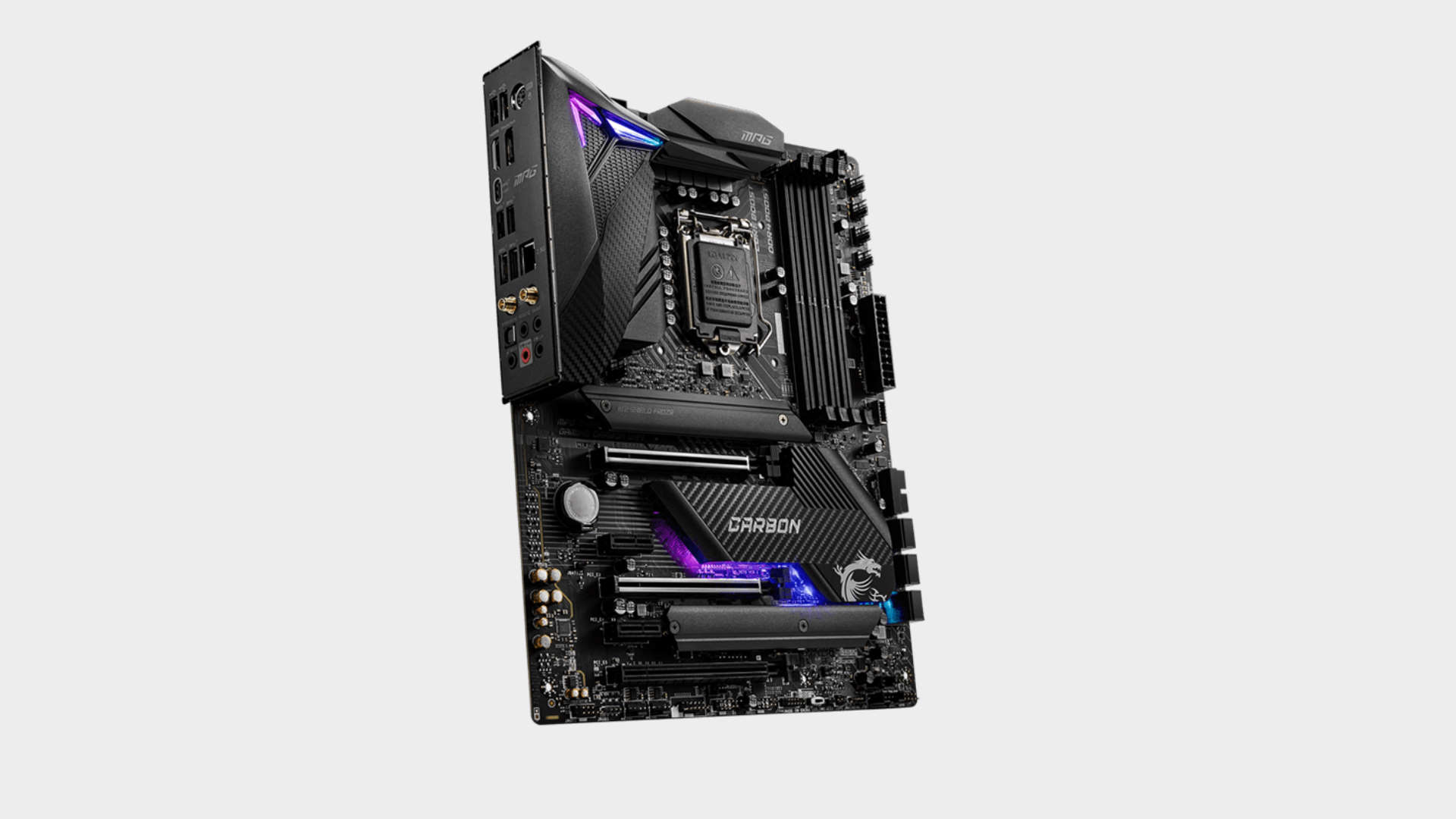
The sparse back panel and lacking OLED displays will assure you we're back into typical motherboard territorial dominion with this MSI offering. The rarified air of the ultra-enthusiast ROG get on up top might make one giddy, but the Z490 Gaming Carbon will bring us back toss off to earth without a bump. Sure, you're never going to father the same level of luxury feature list every bit you'll happen with either the Maximus Twelve or MSI's personal Godlike boards, but when IT comes to the kooky and bolts of pure performance, it's right heavenward there.
Where it matters, in the gaming performance stakes, there's practically cypher between any of the Z490 boards we've tested, and it's only ever a little behind when it comes to the factual Central processor performance in productivity apps. However, when it comes to overclocking, the MPG Z490 Gaming Carbon WiF inevitably stern't compare to the big boys, with our 10900K lengthwise at its tip.
The power componentry and cooling aren't plenty to ba the thirsty CPU from throttling when IT's pushed to its 5.3GHz wholly-effect maximum. But, while that might mean it's non the board you'd choose for an overclocked Heart i9 machine, that's a tiny recess of gamers, and for either i5 Beaver State i7 CPUs, the MSI Gaming Carbon is still a quality home for your Comet Lake CPU.
Best Intel B460 motherboard
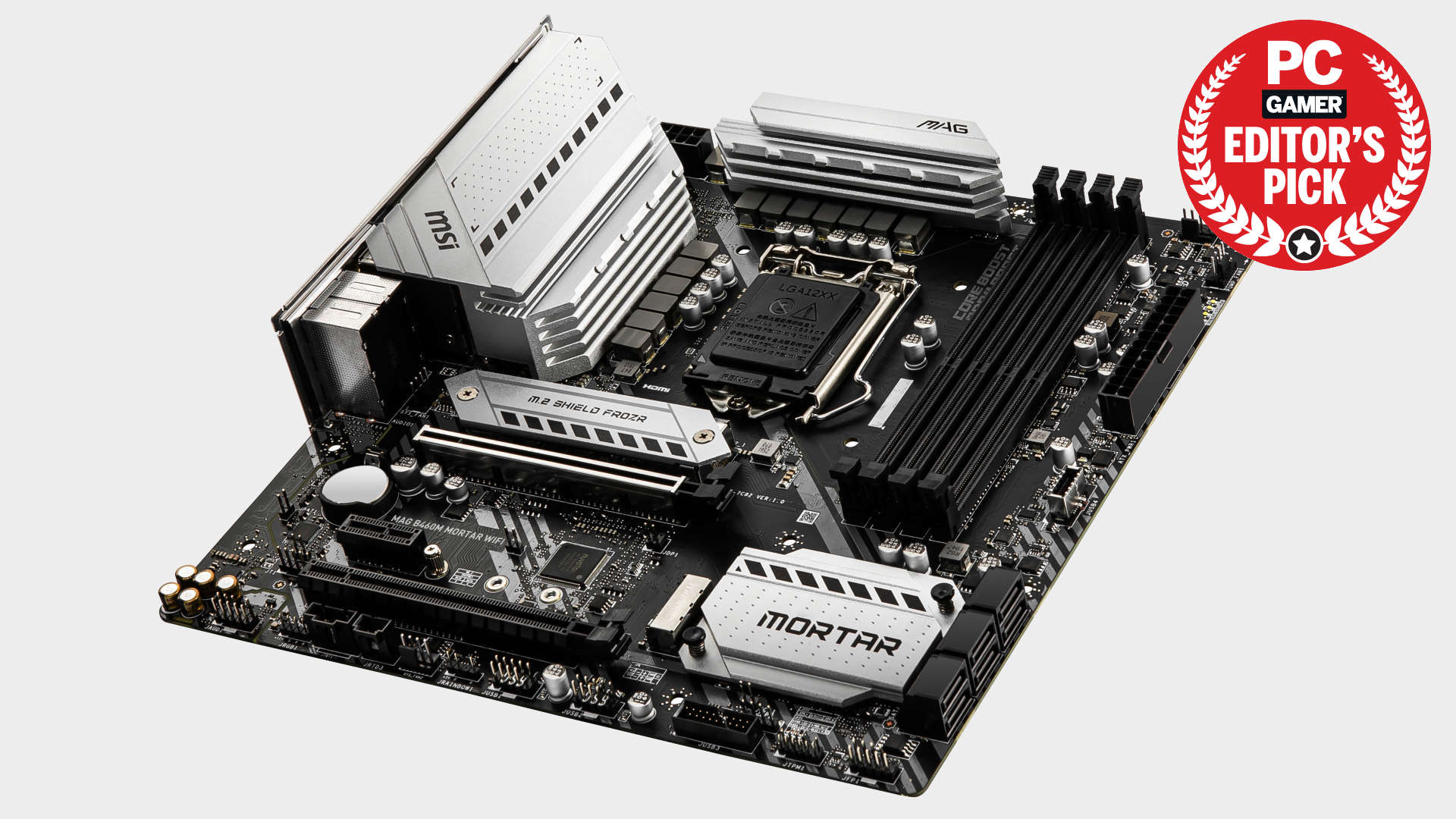
Grabbing one of the foremost Z490 motherboards might be appealing to your inner elitist, only the sticker price stun is in spades a problem. Trusty, it would be nice to have 10Gb LAN, seven M.2 slots, or quad GPU support, simply whoreally needs all that stuff? Most of us testament comprise absolutely happy with a quality B460 motherboard, such as the MSI MAG B460M Mortar WiFi.
If you arse put up with the retentivity speed limitation and have no intention of overclocking (well, with a K-series C.P.U. anyway), and so this is the kind of display board that should be happening your PC building wishlist. It ticks most of the important boxes, and at $125, it's well priced, though the competition is tough with galore premium B460 motherboards priced in that range.
It's got a strong VRM configuration, 2.5Gb LAN, Wi-Fi 6, and satisfactory, if not specially of import, I/O. Pairing information technology with a 65W non-K CPU and having a crack at imposter overclocking is definitely worth the minimal efforts too. If you can animate with the upper limit DDR4-2666 upper, something like an Intel Core i5 10600 and B460M Mortar, paired with a decent mid-range GPU, would deliver a quality, affordable play combo.
Read the full MSI MAG B460M Mortar WLAN reassessmen.
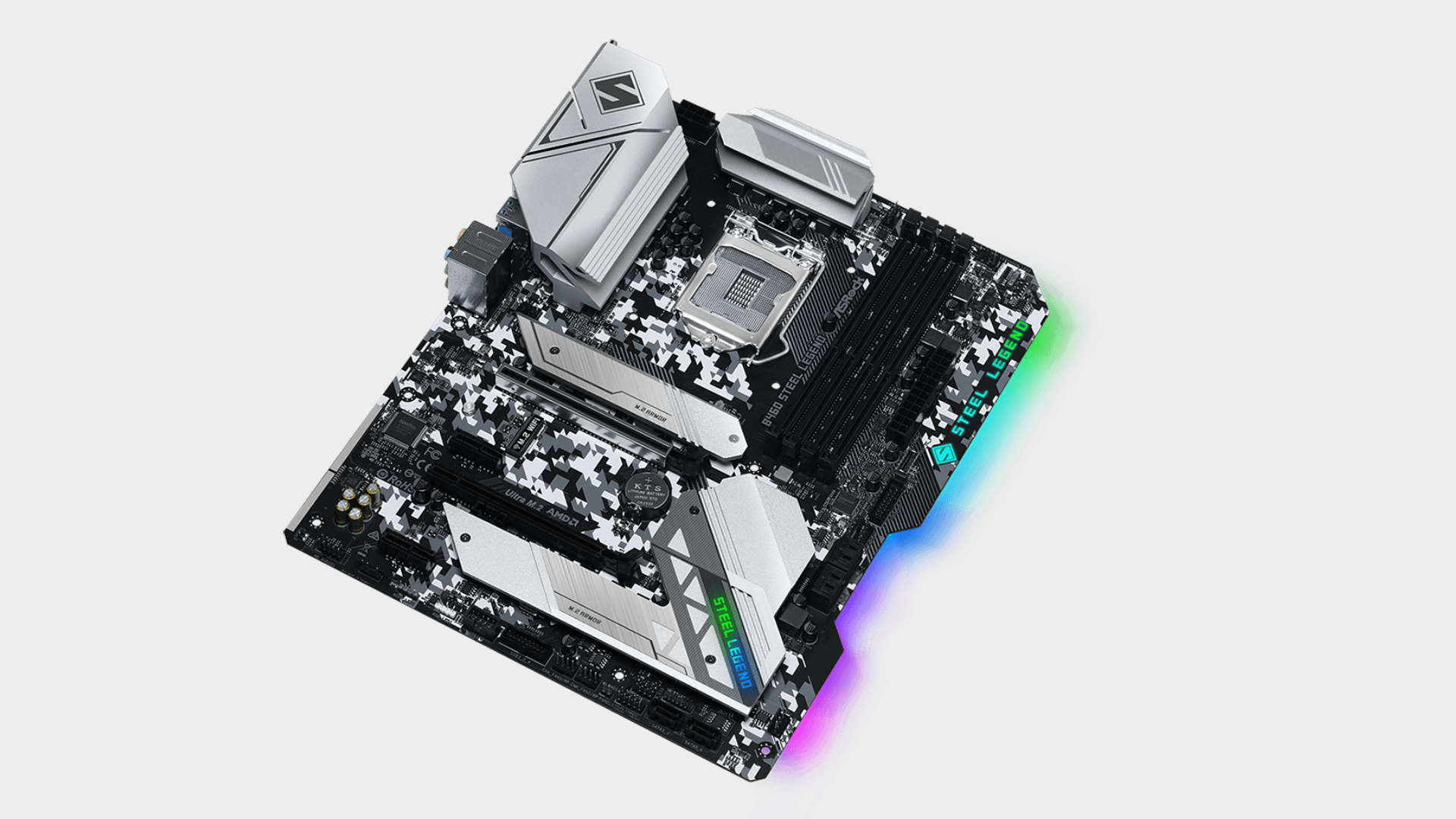
The ASRock B460 Steel Legend is an awesomely onymous middle-range B460 entry. At USD 120, it's what we'd call a mid-range B460 board. A seem over the spectacles indicates that your $120 is well worn-out on more or less life-or-death areas. You get a mate of heatsink-covered M.2 slots, an e-key M.2 one-armed bandit for an optional Wi-Fi card, a front USB Type-C cope, and a good helping of RGB onboard.
The accrued power demands of 10th generation CPUs mean motherboards generally have to admit improved VRM designs, and on that battlefront, the B460 Steel Fable is well provided with. It includes a 9+1 phase VRM hopped-up by a single 8-Pin EPS connector. Each stage can deliver up to 60A. Mind that overclocking is not allowed on B460 motherboards, so the VRM will not visit extreme loads as you mightiness get with an all-core overclocked Intel Center i9 10900K.
The ASRock B460 Steel fable leave appealingness to buyers who aren't so interested in bells and whistles simply want a wholesome ATX board able of powering some 10th Gen CPU without bursting into flames. Integrated Wi-Fi would have been a nice cherry happening top for the price, and that's arguably extraordinary of the reasons we favour the MSI B460M Mortar. But the ASRock B460 Steel legend is still a extremely capitalistic offering and comes extremely recommended by us. It shows its nerve, one might enounce. If it had Wi-Fi, we might steady have said it was legendary.
Read the full ASRock B460 Steel Caption review.
Scoop Intel Z390 motherboard
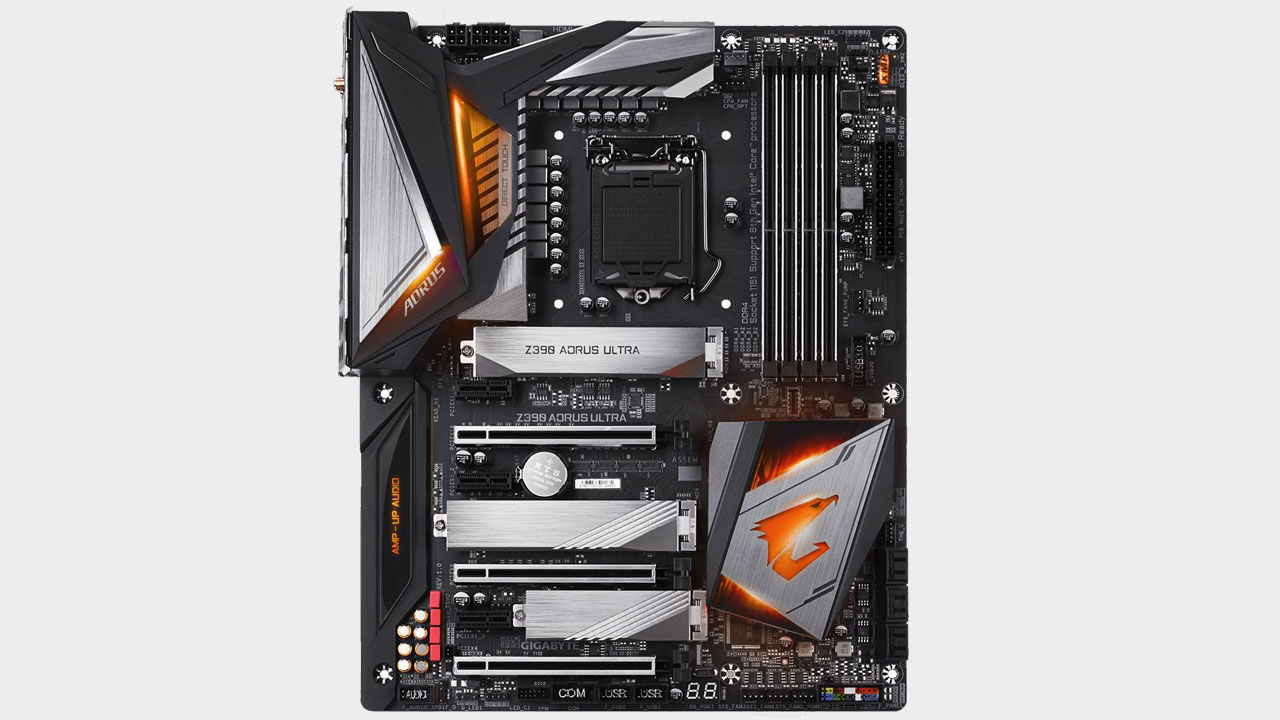
The Gigabyte Z390 Aorus Ultra competes with the MSI Z390 Gaming Pro Carbon Atomic number 89 and the Asus ROG Maximus Eleven Hero (Badger State-Fi), take down price tag along, and more features. It has triple M.2 slots for your super-speedy NVMe SSD needs, Intel Badger State-Fi Wave2 and ethernet, a weighed down RGB treatment with triple headers, and ALC1220 audio. You'd take over to climb redress to the top of the merchandise push-down storage to get the aforementioned from MSI and ASUS, both of whom offer a little more refine but as wel charge plenty for the privilege. Though in that respect's a fate to be said for uttermost motherboards, this is a great measure Intel board.
The only veridical downside for America is that this mobo is perhaps a little too flashy and may not befit more close gambling builds. Thankfully, you can disable all the RGB bling within the BIOS if you wishing, though other elements may still clash. But that's a shrimpy criticism of an otherwise top plank.
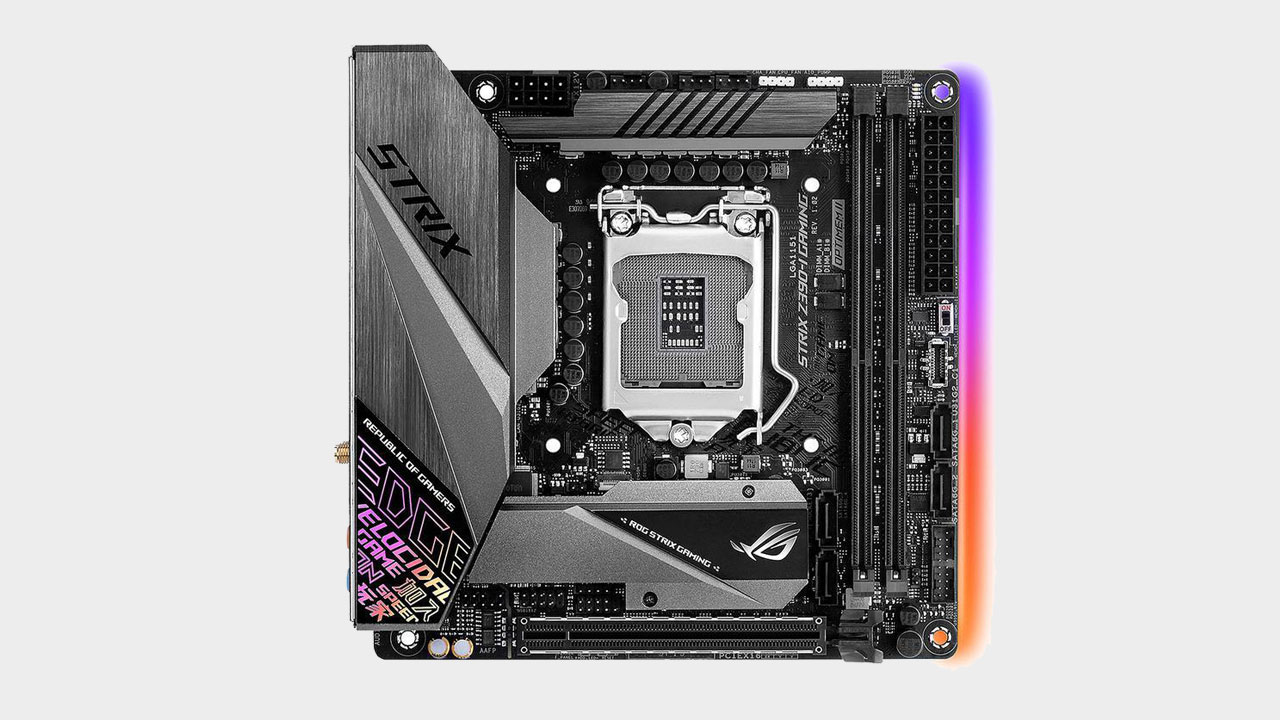
Arsenic the price drops and the past Z370-founded posture disappears from vendors, ASUS's Strix Z390-I Gaming moves into the boutique ITX section's top spot. Despite its bantam size and dearth of upgrade options, the ROG Strix Z390-I Gaming provides excellent operation and value. Boasting stalls 5GHz overclocks using several memory speeds, including 3,600MHz with tweaking, its single PCIe x16 slot pushed top-ledge graphics cards to speeds that matched or exceeded almost Z390 ATX boards during testing.
The smallest Strix has a protracted features list, with no shortcomings contempt the tiny form factor, including dual PCIe Gen3 x4 M.2 slots, Intel v219 ethernet, upgraded Intel 9560 2x2 802.11ac Wi-Fi, and an ALC1220A audio codec nourished by isolated circuitry and headphone amps. Despite the dumb set of features, the Strix Z390-I's clean design makes quick system assembly and configuration an important consideration for ITX fishing rig building.
It's worth noting that this board commode beryllium hard to happen, only the preceding contemporaries ROG Strix Z370-I model, with its slimmer design, remains an fantabulous option, especially at clearance prices.
Outflank AMD X570 motherboard
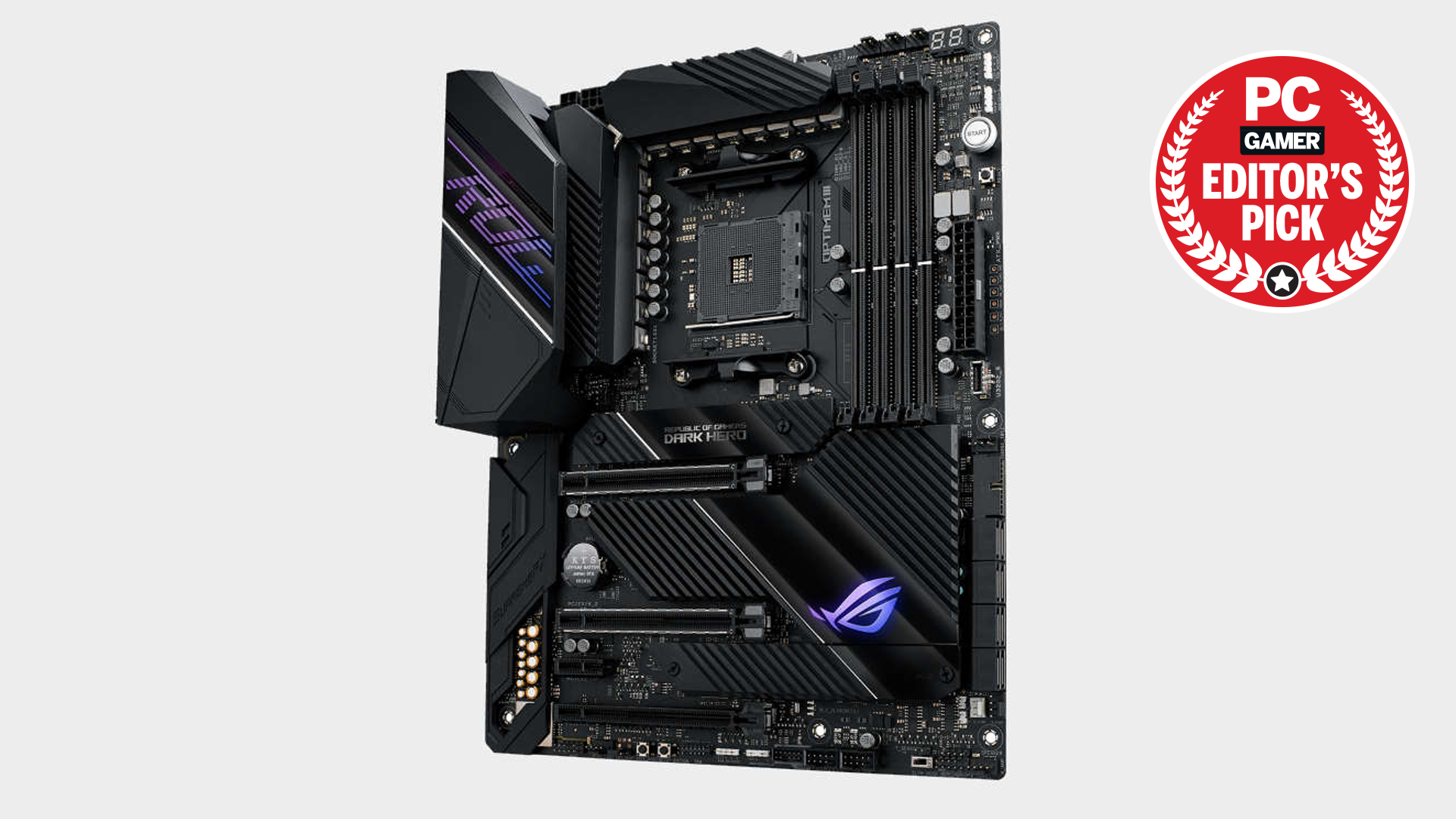
Asus' ROG Crosshair Octonary Dark Hero wants to be the hold out AM4 motherboard you'll ever need. But what is it that makes a great motherboard? Features are important, American Samoa is a unfluctuating and refined BIOS, evaluate for money, a good design, simply sometimes nonmaterial. Sometimes it's that the damn thing works.
Motherboard examination is often one of the most painful things a technical school journalist has to do. With some boards, you have to fight it to twig to practice what you lack, or expect it to, or have to operating room nut case up some voltage setting to a level you wear't really want to, but the Dark Hero just boots the first clock, even as we played with the memory filaree and timings and the Infinity Fabric.
The Crosshair Octonary Dark Hero might not be the best AM4 motherboard always made, we'd have to review a few hundred others to make that claim, but information technology's an easy exact to make that the Dark Hero is for sure one of the best AM4 motherboards we've ever victimised. Time and months of user feedback bequeath determine if the Benighted Hero assumes a position As one of the truly legendary ROG motherboards, just we wouldn't bet on against that on.
Read the full Asus ROG Crosshair VIII Drab Hero recap.
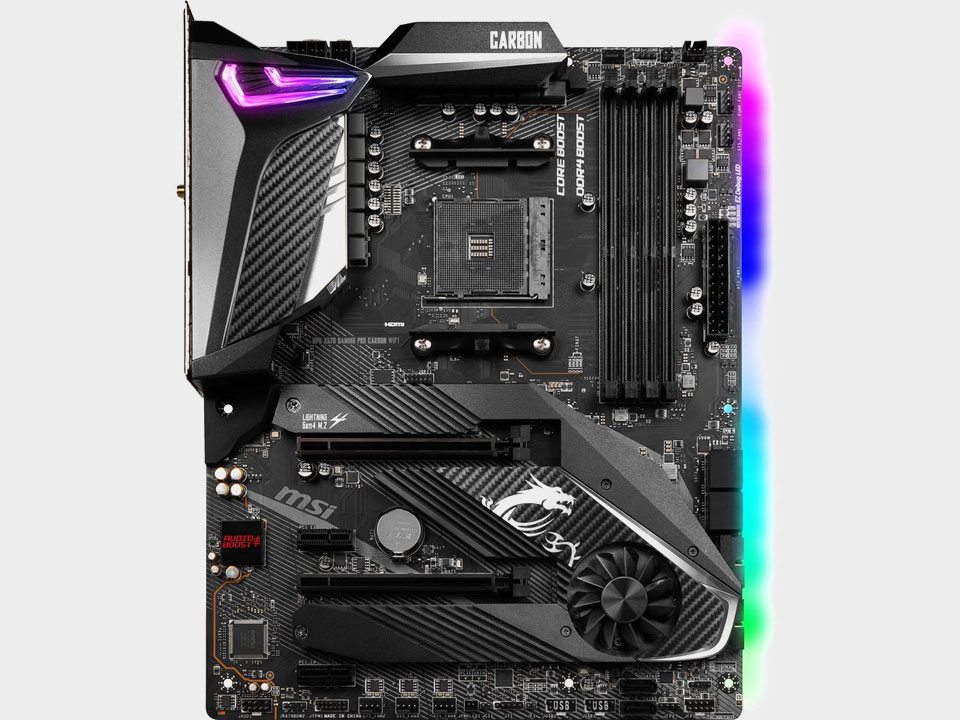
The MSI MPG X570 represents an amalgamation of bleeding-edge motherboard tech built to get on the most out of AMD's 3rd gen Ryzen CPUs. Information technology has quaternity DIMM slots that buttocks handle speeds up to 4,400Mhz and ii M.2 slots sporting PCIe 4.0.
The rear I/O panel features heptad USB Type-A ports for peripherals and a single USB Type-C port for connectivity and unpeasant-smelling-cannonball along data transfer. On that point are headers for the included Wisconsin-Fi antenna to help with wireless connectivity, atomic number 3 well as a gigabit ethernet port. The MPG X570 supports WI-Fi 6, and while that does necessitate a Badger State-Fi 6 compatible router, it's backward compatible with other Wi-Fi standards and gives the potential for a speed boost down the product line. Also of note is the HDMI port, which many X570 boards overleap (not that we'd really recommend victimization an AMD APU with mainstreamed art in a high-terminate board the like this).
The MPG X570 features sufficiency compatibility to get the most out of your hardware now and in the future, provided you're willing to pay a premium for information technology. Piece it's certainly an excellent mobo, if you aren't already committed to a shopping list of top-of-the-demarcation components now or shortly, you may want to consider a slightly less expensive display board for your needs.
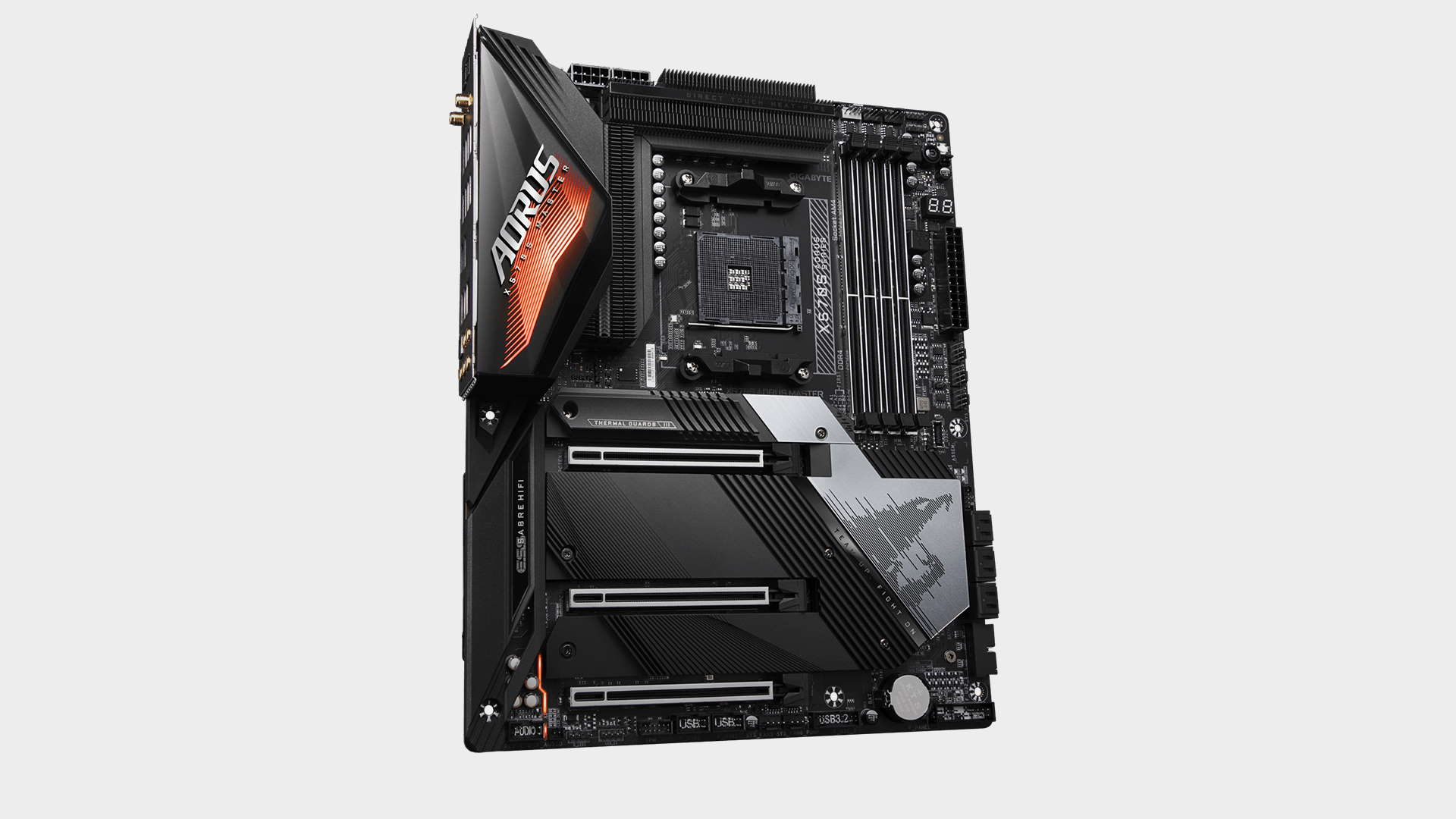
Despite the X570 chipset showing its age, Gigabyte's X570S Aorus Sea captain feels like an centenarian dog that's learned both new tricks. The fact that IT comes with four M.2 slots alone is impressive along with decent heatsink. Truly the cooling system all approximately gets a thumbs upwards from us. The finned VRM heatsinks add a ton of surface area.
Our alone rattling knock cold against the Aorus Headmaster only offers single 2.5G LAN and lacks 5G which is a little a bummer. That being same it's even one of the better AMD motherboards out there. I'm a sucker for a motherboard with a ton of USB ports this mobo has SO many.
The Aorus Passe-partout is still keeping AM4 and X570 relevant thanks to its many USB ports and storage options. Regular at $400, it's got enough features (and looks beneficial to boot) to justify the higher price point.
Read the full Gigabyte X570S Aorus Master review.
Best AMD B550 motherboard
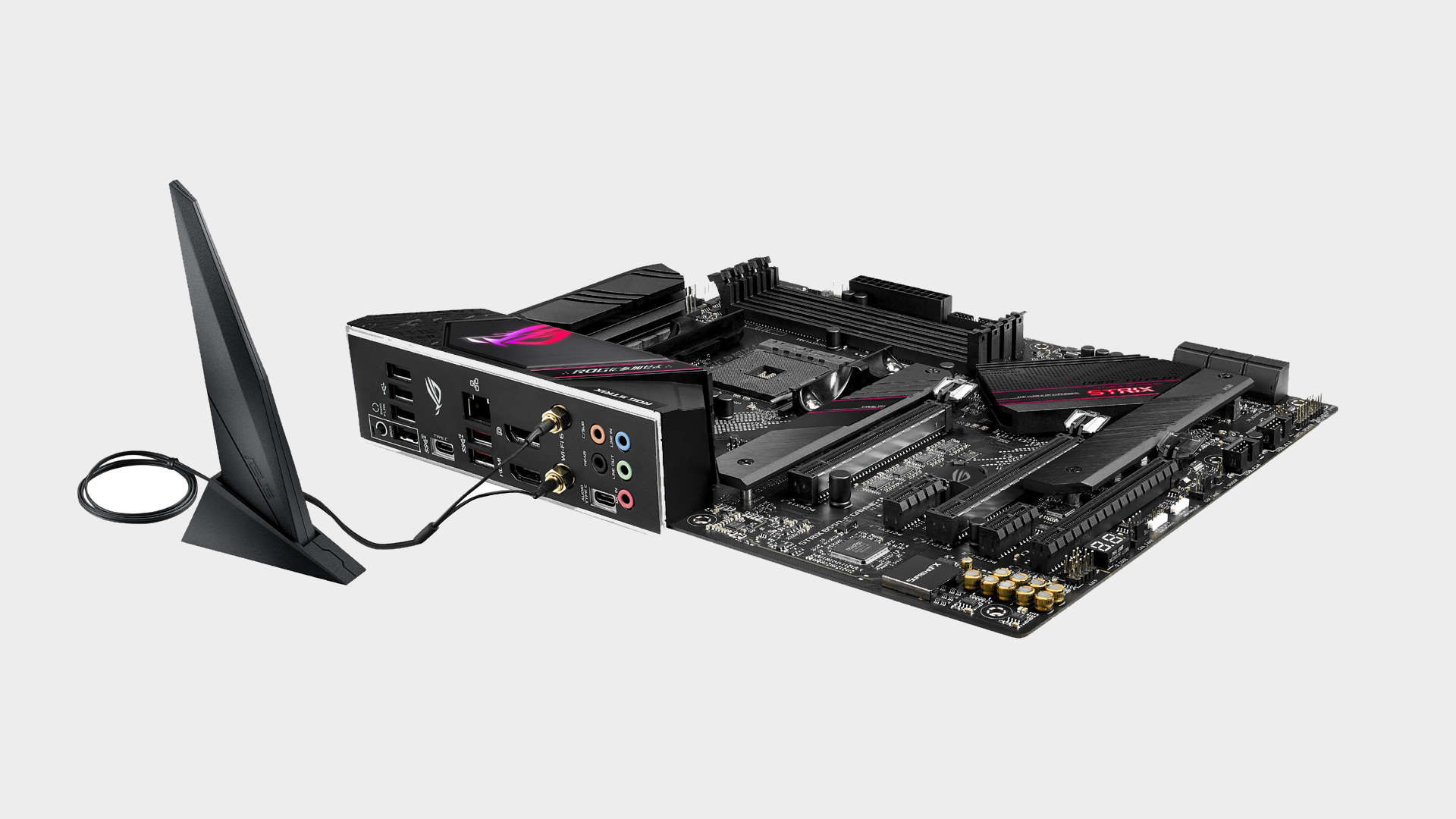
Sure, the Asus ROG Genus Strix B550-E is the corresponding price as other X570 motherboards; as a matter of fact, it pretty much matches our darling of AMD's top-end boards, the MSI MPG X570 Gaming Pro Carbon. But it's a premium motherboard, with all the trappings you'd expect from Asus' Republic of Gamers stables, such as 14+2 office stage, M.2 heatsinks, and pre-installed backplates. You as wel beat Wi-Fi 6 wireless networking as well as Intel 2.5Gb ethernet to a fault. And RGB LEDs, of course. If you're looking at construction a Acid 3 arrangement, then the requirement BIOS updates should come by January for this motherboard.
Performance is typically good for a high-end Asus plug-in, twin X570 motherboards for gaming performance without issue. That said, of the B550 boards we've tested, it's the right more affordable MSI board that actually comes out top in our straight public presentation testing. But the Asus can overclock far better, even off if it does chew up more raw superpowe from the plug on the full-length.
The Asus ROG Strix B550-E Gaming is the whole box then, and right straight off is our all-more or less pick for the best B550 motherboard. Though that noneffervescent feels like a tough recommendation when X570 boards are the Lapp price…
Read the full Asus ROG Strix B550-E Gaming review.
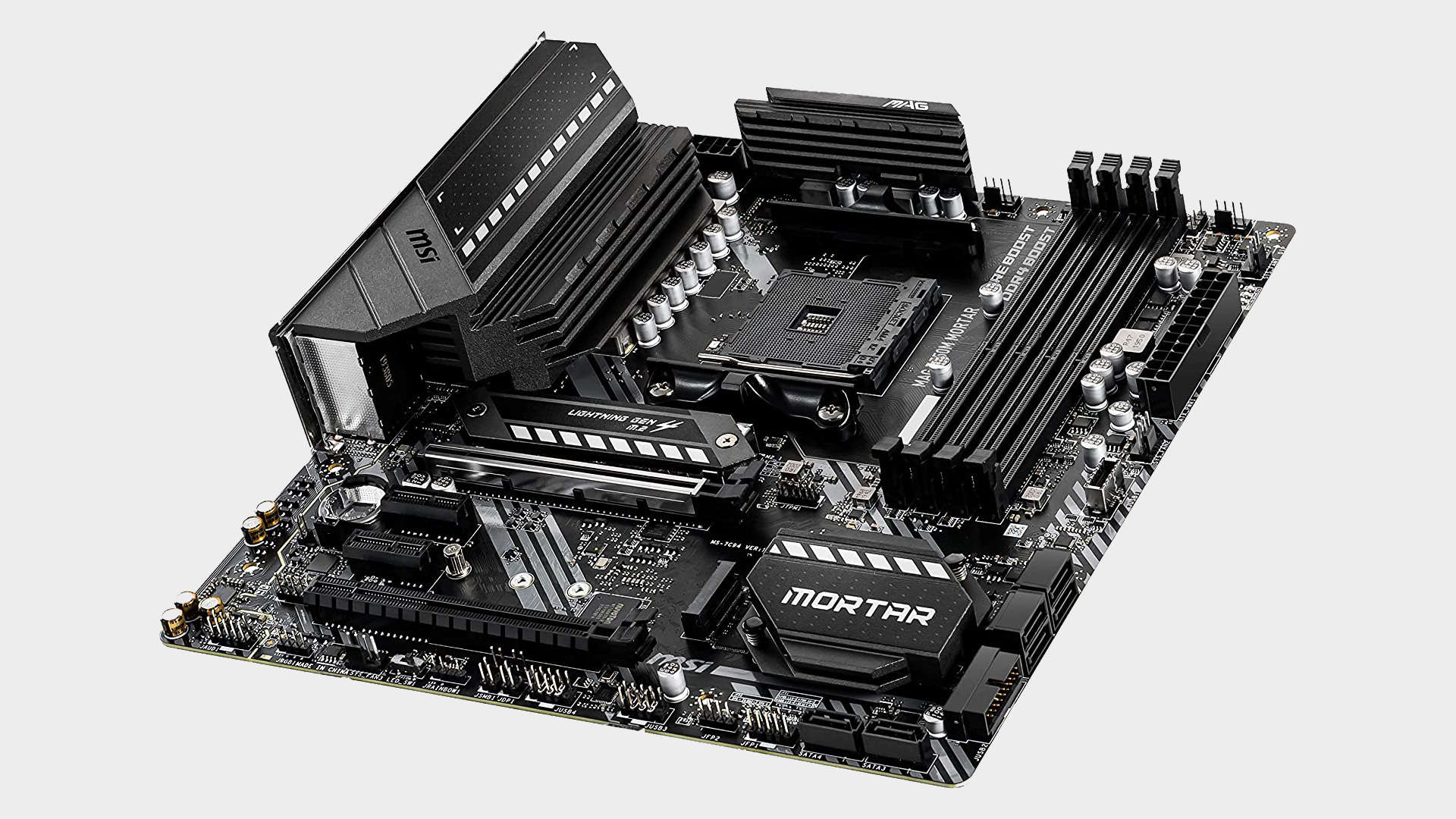
When it comes to gaming performance supra all else, MSI's micro-ATX Magazine B550M Mortar is your best bet for an inexpensive next-gen Ryzen machine. Information technology comes in around the $160 mark, making information technology cheaper than a great numerous X570 and other B550 motherboards on the market right wing like a sho.
The gaming border rates of the MSI B550 Trench mortar put it supra the rest of the B550 crew we've tested so FAR, and indeed its straight CPU performance puts it up thither with some of the superior X570s. That bodes well if you're looking for an affordable home for your AMD Ze 3 Processor of the future (BIOS updates to support Ryzen 5000 chips are due to start rolling prohibited in Jan); this B550 has a big chance to ensure it performs to its fullest stock-clocked potential without breaking the bank.
But you bequeath personify missing out connected extra PCIe 4.0 M.2 and x16 graphics slots if those extras beggarly a lot to you. You can also choose to ditch radiocommunication networking, contingent whether you pick the directly Trench mortar OR the more expensive Mortar Badger State-Fi version. The 8+2+1 power stage contrive is arguably a much unwelcome miss, even so, as that results in a control board that will not spark any overclocking joy in your heart. But, Eastern Samoa an affordable gambling plug-in without OC pretensions, information technology's a great shout.
Read the full MSI Magazine B550M Trench mortar review.
Record-breaking AMD A520 motherboard
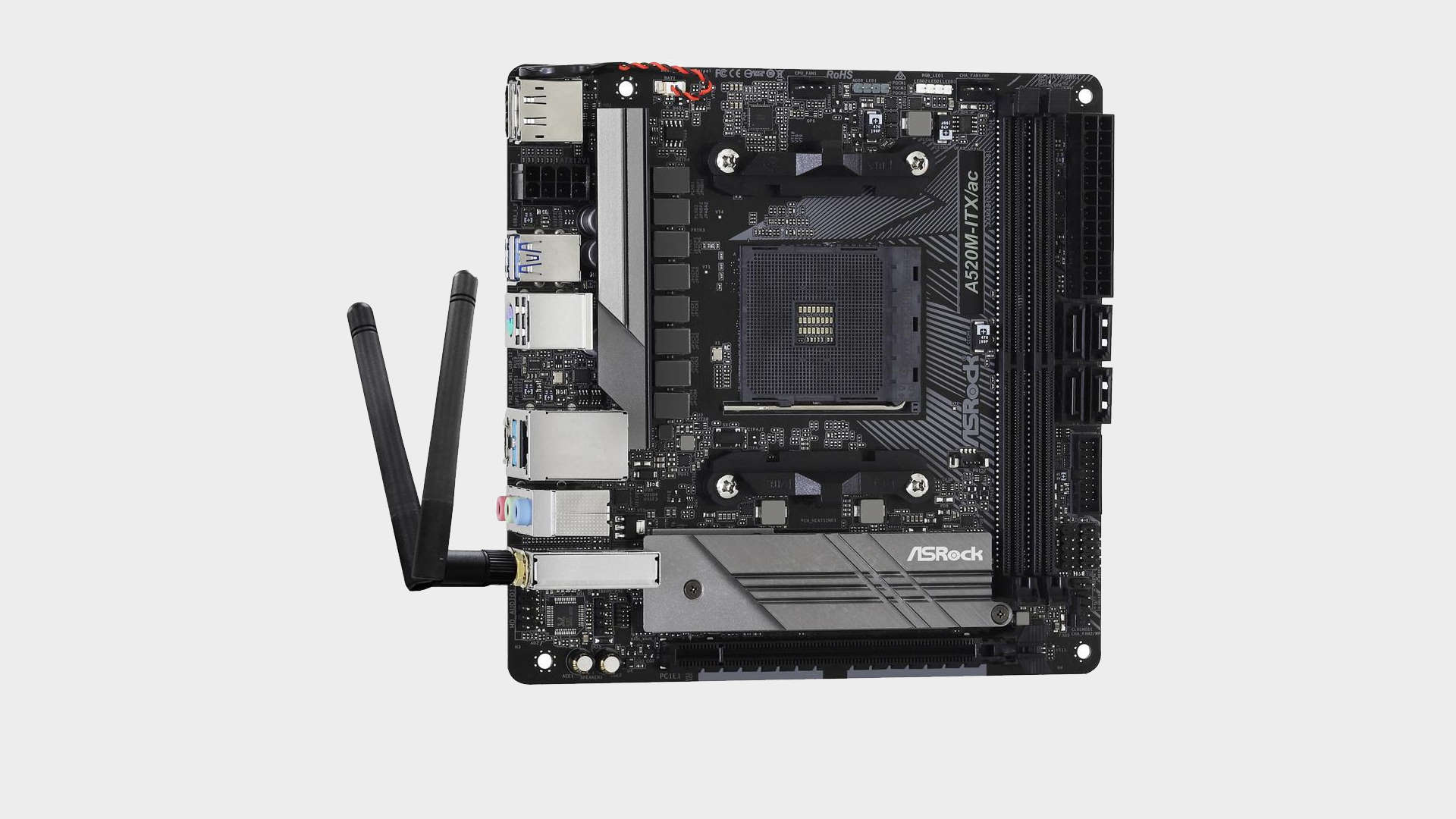
AMD's budget Ryzen motherboard chipset, the A520, has largely slipped under the radar. While B350 and B450 motherboards were mostly regarded as entry-level, A320 was strictly seen as the resolutely low end.
The introduction of B550 motherboards, and their associated go upward in price, left a epic pickle in the sub-$100 market. Introduce A520. If you're on a tighter budget and don't care about PCIe 4.0 or the overclocking support offered by B550, then the A520 motherboards might be exactly what you need. There's cheap, and there's really cheap, but a decent A520 get on can much or less do everything aboard at three-fold the price can.
Then there's the crimson on top, which supports AMD Ryzen 5000 series CPUs and, well-nig atomic number 3 significantly, Ryzen 4000 series Genus Apus. Combine a Zen 3 CPU with a motherboard such as this ASRock A520M ITX/ac, and you'll be able to build an affordable and compact system that can beat any Intel break away in whatsoever workload.
The ASRock A520M's audio is a bit of a letdown, but that's something that budget boards ofttimes via media connected. A gamer listening to compressed audio assets in-game likely won't be whatever little immersed. The little ASRock A520M ITX/ac has it where it counts and will serve you well at the heart of a budget gaming system. It benefits from the strengths of the Ryzen political platform and adds some future-proofing into the immix. ITX fans looking for a capable budget AMD Ryzen selection should definitely give birth this united on their short list.
Study the loaded ASRock A520M ITX/actinium revaluation.
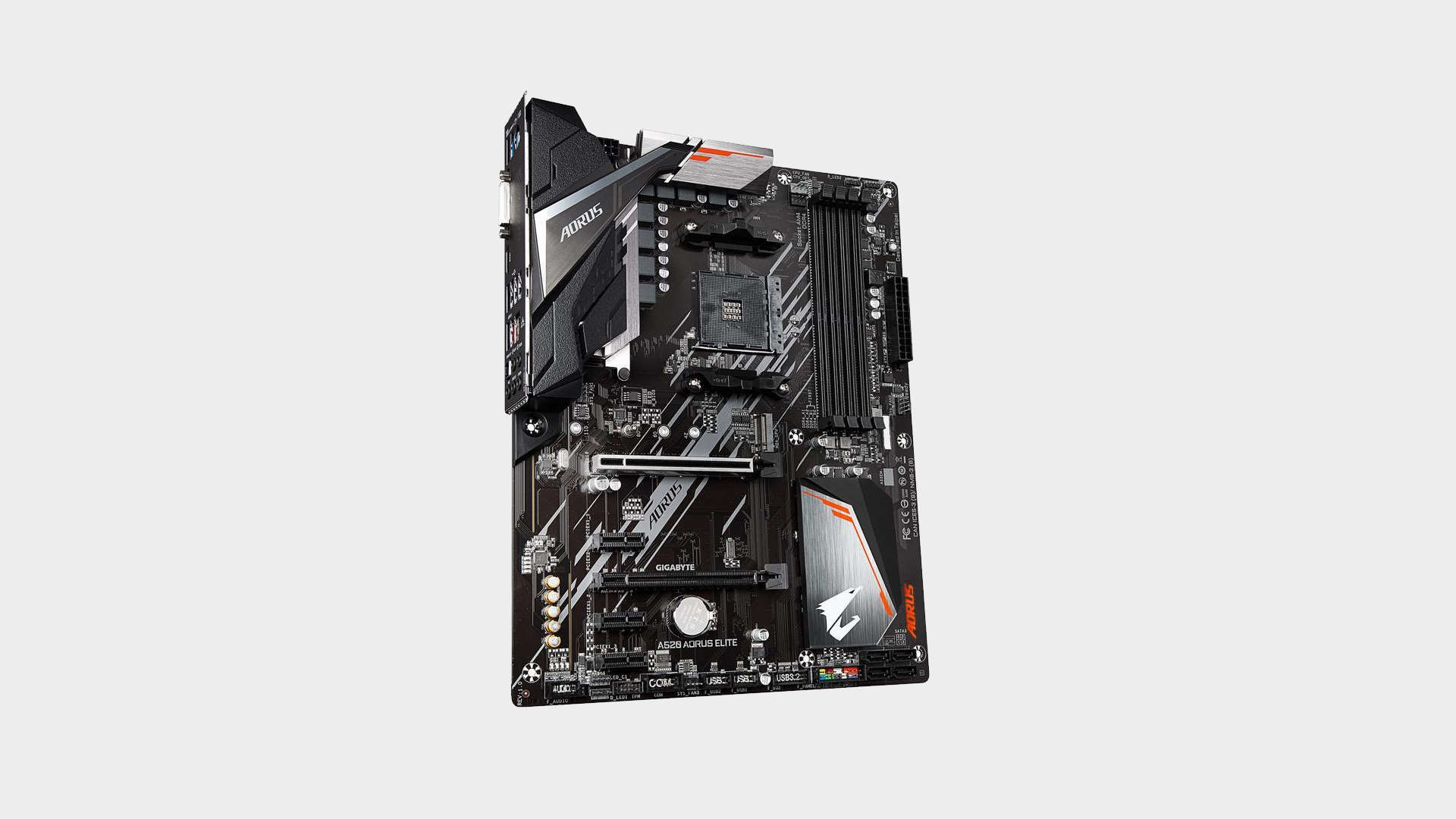
AMD's A520 motherboard chipset mightiness not work for the sexiest of PC components, that's for certain. You probably wouldn't buy out unity to claim property at the warmness of your cool build surgery Nvidia RTX 3090 gaming scheme. When you consider the chipset itself, it doesn't really overlea out in terms of real-world crucial features. There's nobelium PCIe 4.0, only no Intel systems have it either, non until Rocket Lake next year.
The Gigabyte A520 Aorus Elite is a steep-end A520 board, which might appear oxymoronic, only if you didn't know what it was, you'd be forgiven for assuming information technology was more of a mid-reach board and not a $90 bargain. It's even got two RGB headers and a further two ARGB headers. About the only thing it really lacks is Wi-Fi, but then do you really expect to have Wi-Fi at this Mary Leontyne Pric?
Gigabyte deserves credit for including audio stacked approximately the ALC1200 codec. Usually, this is reserved for usance with more expensive motherboards. If you're on a budget, this Gigabyte A520 Aorus Elite is cured worth a look. It leaves Intel's budget B460 boards looking decrepit in comparing, plus you get the benefit of next-generation Ryzen compatibility. Is it for everyone? No, but the Gigabyte A520 Aorus Elite group, unlike near all preceding A320 boards, definitely does not mean loud and awful.
Record the pear-shaped GB A520 Aorus Elite revaluation.
Gaming motherboard FAQ
What's the most big constituent in buying a motherboard?
You need to know which processor you want to be building your current fishing rig around. Are you firmly tying yourself to the mast of the good ship Intel as IT plows on through the roughest waters it's known? Or are you going to flee the slacken off of AMD with pride? Disposed the AMD Ryzen 5000 CPUs' execution, I know where I'd be putting my money.
What really matters when purchasing a motherboard?
Other than knowing which processor you'atomic number 75 expiration to be fitting, sized matters when picking up a motherboard. If you're building out a standard ATX scale gaming PC, then pretty much whatsoever motherboard is open to your whims, but if you want to go for a smaller physique, either Little ATX or Mini ITX, then you'll involve a corresponding mobo.
That doesn't necessarily mean sacrificing performance or fundamental features anymore. A single PCIe slot is Thomas More than sufficiency for today's SLI/CrossFire-less GPU world, and straight-grained any Mini ITX boards will come with multiple M.2 SSD slots.
The scale will impact pricing, however. Interestingly Micro ATX boards are often the all but affordable, while Mini ITX options can be the most dearly-won. We've picked our top two favorite gambling motherboards for for each one of the of import Intel and AMD chipsets to apply you the best options around.
John I overclock on whatever motherboard?
No. Thither are absolutely restrictions in place to stop that, especially on the Intel root. It has opened up storage overclocking crossways its 500-series chipsets, but still, the Z590 is your only chance of overclocking the latest Rocket Lake K-serial CPUs. Merely don't vexation, they put on't overclock very well.
AMD is more generous, allowing whol its CPUs and nearly of its motherboard chipsets. Basically, if you make sure not to go for the cheapest Ryzen board, one with an 'A' at the front of its nomenclature, then you're good to tweak. Though again, there really are limited returns.
Argot buster - motherboard terminology
ATX, Small-ATX, Mini-ITX
The well-nig common grade factors/sizes of a motherboard from largest to smallest, which beyond physical dimensions determines which cases it'll fit into and (broadly) how many expansion slots are available. There are other, less common form factors (XL-ATX, HPTX, etc.), only these three are the most ubiquitous consumer pattern factors.
USB Header
A connexion on the motherboard that allows you to work a cable to the showcase to sum up additive USB ports, typically along the front panel (though around cases provide top or lift panel slots as well).
BIOS/UEFI
Basic Input/Output System/Merged Extensible Microcode Interface connects the hardware and software that lives on the room (the firmware) to the operating system (OS, such as Windows or Linux). They allow you to correct organization-level settings, such as fan speed or RAM frequency. UEFI has largely replaced the experienced BIOS criterion.
Expansion Slots (PCIe Slots)
Marginal Component Interconnect Express slots on the motherboard are planned to fit add together-in cards like graphics cards, SSD cards, devoted solid cards, etc. PCIe slots are metric in both length (x16, x8, x4, x1) as well as by the number of data transmitting lanes they bring home the bacon (x16, x8, x4, x1). It's possible for an x16 slot to only provide 8 lanes of data, e.g., which means the maximum thinkable data transpose rate is halved (though in many cases, because PCIe provides so much a high ceiling for transfer speeds, a take down number of lanes doesn't make a tremendous difference).
DIMM Slots
Treble In-Line Computer storage Module slots, the slots on a motherboard where your RAM lives. The number of total slots contributes to the maximum amount of Chock up your system can handle, paired with the chipset and OS.
Chipset
The logic allows the varied parts of a motherboard to talk to each former. The chipset determines which C.P.U. generations a motherboard is sympathetic with and what tally-in card game can be used.
SATA Ports
Serial Advanced Technology Bond ports, an interface for connecting computer memory devices/drives to a motherboard (HDDs, SSDs, visual drives, etc.). The number of somatogenetic ports on your board, combined with ports for NVMe storage, will specify the total number of storage drives you can possess connected to your PC at any prison term.
Source: https://www.pcgamer.com/best-gaming-motherboards/
Posted by: wardnearst.blogspot.com



0 Response to "Best gaming motherboards in 2022 | PC Gamer - wardnearst"
Post a Comment